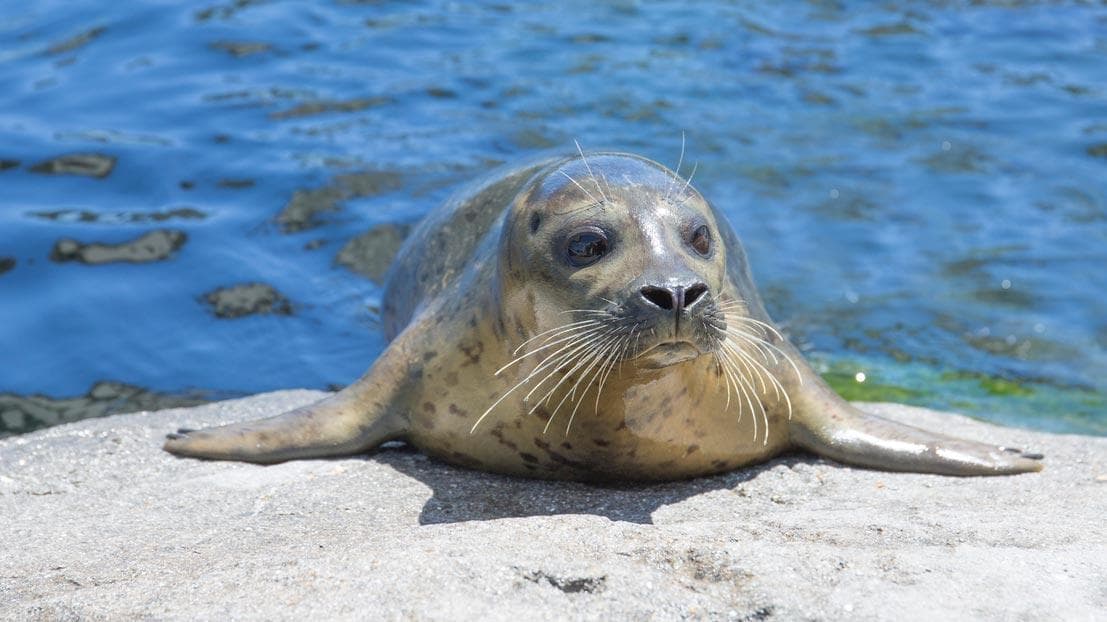Length: 5-6 feet
Weight: 180-285 pounds
Harbor seals are pinnipeds, a group of animals that includes seals, sea lions, and walruses. Harbor seals can display a wide variety of coat colors from silver and grey to dark brown, but most will have a pattern of dark rings or spots. They have a dog-like head and V-shaped nostrils that they "seal" closed while underwater. Plump in appearance, they carry an important layer of fat called blubber that insulates their organs from the very cold waters in which they reside. Their front flippers have structural similarities to the front limbs of land mammals, including claws. Unlike fur seals and sea lions, harbor seals are considered “true seals," with short flippers and no external ears. Their dark “oily” eyes allow them to see underwater with limited sunlight as they hunt for fish and other meals.
Harbor seals have five known sub-species. Currently, we have two of the five here at the Aquarium: western Atlantic harbor seals (Phoca vitulina concolor) and eastern Pacific harbor seals (Phoca vitulina richardii). While the sub-species might have different coat colorations and ranges, they are all similar in other traits.
People often confuse harbor seals with sea lions, and though they are both pinnipeds, there are distinguishing characteristics.
Diet
Seals in the ocean feed on whatever species of fish are available and in season. In addition to fish, they feed on cephalopods and crustaceans found onshore, as well as other small animals found in the water and along the ocean floor.
Habitat
Harbor seals are one of the most widespread of the pinnipeds and are found throughout coastal waters north of the equator, from temperate to polar regions. The two sub-species residing at the Virginia Aquarium have a more limited range: Phoca vitulina concolor is found along the western North Atlantic coasts (Canada, USA including Virginia, Greenland), while Phoca vitulina richardii is found along the eastern North Pacific coast (Alaska, some Russian islands, Canada, USA).
When onshore they prefer rocky reefs, sandy beaches, tidal mudflats, and sandbars along the coast, in bays, or in estuaries where swaths of land are uncovered at low tide. They spend about half of their time on land and half in the water. They haul out of the water in the summer months when they shed their coats, and rest to regulate their body temperatures. Their iconic “banana” pose is suspected to be a temperature-regulating behavior.
Migration
At one time, harbor seals were considered non-migratory and typically thought to stay within 15 to 31 miles of where they were born. However, tracking data has revealed that they sometimes travel 62 to 486 miles from their tagging location, often to feed on seasonally-available food or to give birth.
Because of their thick blubber layers, harbor seals prefer colder water. Here in Virginia Beach, seals can be spotted off-shore from about December until May. However, when the water temperatures rise with the summer sun, they will migrate north to the colder waters of New England.
Reproductive Behavior
Like all mammals, harbor seals birth live young and nurse their offspring. Their breeding season is usually quite long, from February to October, and they generally give birth to one pup between April and July. The gestation for these seals is 9 to 11 months and babies can weigh anywhere from 8 to 26lbs. at birth. Harbor seals are capable of swimming from birth, but might be observed riding on their mothers' backs when they are tired. However, moms are not generally observed to have a strong bond with their offspring after birth.
Locomotion
On land, their locomotion is called “galumphing,” and appears to be laborious and clumsy. However, when swimming, they can reach speeds of 12mph with the help of their strong hind flippers. They are capable of diving to more than 1640 feet and can stay underwater for almost 30 minutes.
Celebrations
Harbor seals are one of the most common marine mammals along both US coastlines. Fortunately, this species is not currently a concern for conservationists, but this was not always the case. At one time they were considered a competitive nuisance for fishermen, so state-financed bounty hunting was allowed in some northern coastal states, a practice that ended in 1960. Today, like all marine mammals, harbor seals are protected under the Marine Mammal Protection Act.
The current population is estimated at 610,000–640,000.
Concerns
Some common threats to harbor seals include becoming entangled in fishing gear, ingesting marine debris, or being injured in a vessel strike. Seals are often mistreated by beach visitors who try to feed, touch, or otherwise interact with the seals. Unfortunately, repeated exposure to humans can result in illness, stress, or seals abandoning pups. Harbor seal habitats are also being destroyed by irresponsible shoreline development as well as careless commercial and tourism practices.





